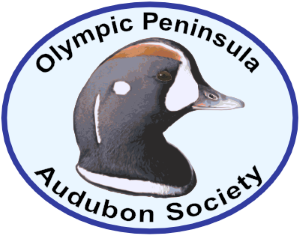Narrative and photos by Dee Renee Ericks
Adam is focused as he pilots the USFW boat carrying 3 OPAS volunteers.
On July 17th, Ken, Dow and Dee Renee catch a boat ride with USFW employee Adam and SCA Mallory for a quick check of the 13 Purple Martin (PUMA) nest boxes on Protection Island. It is a beautiful morning with cool breezes off the water, and lingering clouds that made one wonder if dry lightening is in the forecast.
As you enter the harbor the scene is alive with birds flying and perched. Pigeon Guillemots and cormorants line the rock breakwater. Glauous-winged Gulls shepherd their new babies along the water’s edge making raucous calls to one another. Seals line the harbor shore and splash as they suddenly enter the water. Seal pups poke their head above water and stare curiously as we pull in.
Pigeon Guillemots, Glaucous-winged gulls, and Pelagic Cormorants greet our arrival.
Glaucous-winged Gull with chicks. Excellent camouflage!
The Protection Island sign stands weather-beaten above the small harbor.
The tide was quite low, so the tall ladder for reaching the dock’s nest boxes comes along for the ride. There are 13 Purple Martin nest boxes on Protection Island, with 10 boxes on the docks.
This is a schematic of the nest location in the dock area. The dark blue areas are dock. Credit: Dow Lambert
In the harbor area, looking south toward the Olympic Mountains.
Protection Island PUMA nest box posts as seen from shore.
We first check the inland boxes located near the USFW maintenance shed, a short walk away.
Dow and Ken secure the inland nest boxes to their post to minimize impacts by wind.
Peering into the top nest box, Dow spots hatchlings about 4 days old. The bottom two PUMA boxes reveal 3 eggs and 5 eggs.
Hatchling Purple Martins. How many do you count? Credit: Dow Lambert
The bottom nest box as seen by the endoscope. Often purple martins will bring in greenery just before laying eggs. Credit: Dow Lambert
As we hike back to the harbor, we are under the gaze of sharp-eyed bald eagles. They surveil the extensive cliff area that contains Rhinoceros Auklet burrows, knowing there are new chicks. We watch as a pair of gulls swoop in to pick up prey, and fly away with their meals.
Glaucous-winged Gull
Back at the docks, we tread carefully on the guano-stained surface as we set up the ladder at each piling. A strong odor assails our nostrils. Up above, Dow carefully inserts an endoscope to check each nest box to document its contents. Meanwhile, Pigeon Guillemots swim nearby amidst our activities, with several carrying prey fish in their bills.
A Pigeon Guillemot toting a sculpin swims near the docks.
A male Purple Martin peers intently toward a nest box entrance following our disturbance. His mate is nearby.
Scrutinizing all photos taken with the endoscope, Dow tallies up a total of 26 eggs and 11-14 chicks (they are hard to count when piled on top of each other). Two of the nest boxes had the beginnings of a nest with a couple of green leaves, suggesting eggs might show up soon. Two nests were not checked as the boxes could not accommodate the endoscope.
Time flies by during our short stay here. Alas, our tasks completed, we must leave this fascinating place.
Adam expertly pilots the boat out of the small harbor.
Ken Wiersema looks skyward above the island as we start our journey home.

